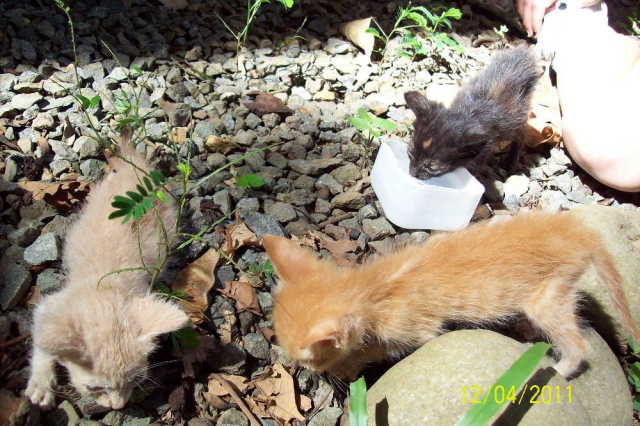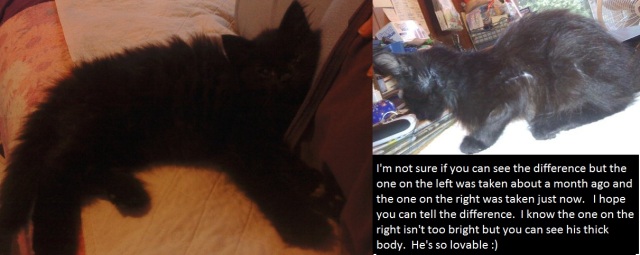QuestionI have a cat that is an outdoor cat. He is a stray that came to me. He cannot come inside because my husbane is allergic to cats. Socks normally comes around evening for food. I noticed today that he had a small glassy white bulge around his ear that made me suspect worms. What is the best thing to get rid of it and what type of worm is that?
There is also a second cat that I have been feeding. She will sniff my fingers, but will not allow me to get any closer to her. I would really like to be able to pet her and show her love. I have been very patient with her, trying to earn her trust. Is there any other way? I have tried treats, coaxing and nothing seems to work.
Thanks
AnswerHi Amanda,
There are no worms that are commonly found to infect the ear area of cats. It is possible that this kitty has one of several conditions:
1. Myiasis: An infestation of maggots, which typically occurs in damaged or weakened skin, such as in wounds, under matted fur, or in skin that has had long contact with fecal matter. Most maggots feed only on dead flesh, but they can become parasitic and begin to burrow into live flesh. These cases require immediate vet attention, not only to treat the initial infection but to remove the maggots that are now eating away at their tissue.
2. Bot Fly Larva: This is also a maggot, which is always parasitic in nature. Unlike myiasis, you will only find one bot fly larva per hole. The cat comes in contact with the eggs of these flies through brush, or the eggs are dropped on them by other insects. When the eggs hatch, the tiny larvae make their way to the skin and burrow under, where they grow for around four weeks in most cases. These larvae get very big! As the larva gets bigger, it starts to create a pronounced bump under the skin. It leaves a breathing hole in the skin, and you can see the worm through this. At first the worm is white, but it darkens in color toward the end of its "gestation". After about 4 weeks, if all goes well, the larva will back itself out through the breathing hole and move on to its next life cycle. However, the larve can cause infections, and if it dies, and can even cause a toxic reaction that can kill the cat. So it's best to have the vet remove it. WARNING: never try to remove them yourself. If you kill the larva trying to remove it, you risk creating that toxic reaction I mentioned. It's better to ignore the larva than to try to pull it out with tweezers yourself, or to smother the larva with Vaseline or kill it with alcohol.
3. An abscess: This is a pocket of infection under the skin, generally caused by a bite wound. A cat's teeth are long and thin and full of bacteria. They can penetrate deeply and deposit germs, but leave almost no wound. The entry hole heals up, but bacteria are sealed inside. The infection continues to build, and pus continues to fester. A bubble begins to appear under the skin, usually with hair loss. Finally, the painful skin will usually rupture, and the pus will ooze out. Abscesses need to be addressed by a vet because the bacteria can spread to the blood stream and cause a fatal condition called septicemia. The vet will drain any remaining pus from the wound and prescribe an antibiotic. They may recommend warm, moist compresses to keep the wound draining. If the wound is severe, a drain may be placed in it.
4. Possibly the beginning of an ear polyp, but these tend to be dark in color. Polyps are round, shiny, soft, non-cancerous growths. In the outer ear, they are generally benign and don't cause much trouble as long as they're small. If they get too large, they can cause discomfort, may bleed and even hinder proper ear cleaning or hearing. These polyps should be removed surgically.
As for your shy cat, persistence is really the only key. Hand feeding extra special treats like chicken and tuna are the best way to earn a cat's trust. Depending on how old the cat was when you first tried to make contact, and her experience with other people, her progress may be very slow. Some cats will never accept any human contact unless they are first forced to accept it, and that would require trapping her and working with her on a very intense basis. But I would encourage you to be patient and persistent.
Good luck!
Jessica

 Newborn Kitten feeding ---? 5-6 WEEKS
Question
Venus
Hello expert,
I have a 5-6 week kitten a
Newborn Kitten feeding ---? 5-6 WEEKS
Question
Venus
Hello expert,
I have a 5-6 week kitten a
 brother and sister loss of cat (16 years)
Question
Jesse on Xmas 2009, Re
kate -
my name
brother and sister loss of cat (16 years)
Question
Jesse on Xmas 2009, Re
kate -
my name
 Injured tip of ear / Follow up
QuestionBagBoy
QUESTION: My 7-month-old cat, Har
Injured tip of ear / Follow up
QuestionBagBoy
QUESTION: My 7-month-old cat, Har
 Orphaned baby kittens in the rainforest
Question
kittens
Hello,
My wife and I are volunteers in
Orphaned baby kittens in the rainforest
Question
kittens
Hello,
My wife and I are volunteers in
 Kitten lossing weight drastically
QuestionTubby before and after
QUESTION: Hello.
Kitten lossing weight drastically
QuestionTubby before and after
QUESTION: Hello.